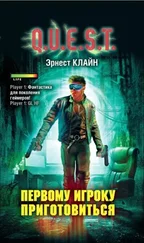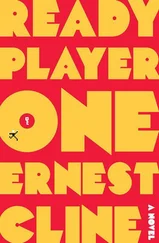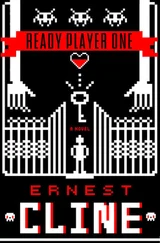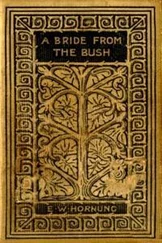“The First Shard has a clue etched into its surface,” I said, turning it over in my hands so they could see it. “A hint about the next shard’s hiding place.”
Aech cleared her throat and read the clue out loud.
“ ‘Her paint and her canvas, the one and the zero,’ ” she recited. “ ‘The very first heroine, demoted to hero.’ ” She raised her eyes to meet mine. “Any ideas?”
I shook my head.
“Not yet,” I said. “But this is the first opportunity I’ve had to try to decipher it.” I pointed to the first line of the clue. “But I think the first line must be a reference to Kira, and her career as a videogame artist. ‘Her paint and her canvas, the one and the zero.’ ”
Aech nodded. But Shoto didn’t respond—he was already lost in thought.
“I’ll buy that,” Aech replied. “But what about ‘The very first heroine, demoted to hero’?”
I recited the line in my head a few times, trying to parse the meaning. But my brain wouldn’t cooperate. It had been a mistake to obsessively rewatch that crash footage for some sign of Samantha. Now all I could think about were all of those charred human corpses I’d seen littering the park where her jet had made impact. The bodies of at least a dozen people—people that Anorak had already killed, without hesitation.
“Come on, Z,” Aech said when I failed to respond. “You must have some ideas….”
“I don’t know,” I muttered, vigorously scratching my scalp in an attempt to jumpstart my brain. “I suppose it could be a reference to Ranma 1/2 ? A heroine demoted to hero?”
I was grasping at straws and Aech knew it.
“Come on, Z,” she said. “Ranma was a boy who changed into a girl, not the other way around. And besides, the clue reads ‘the very first heroine.’ ”
“Right,” I said. “You’re right. Sorry.”
We stared at the inscription on the shard in silence while Faisal watched anxiously from across the room, his eyes wide with fascination.
As precious seconds continued to tick away, I began to wonder if I was going to have to swallow my rapidly dwindling pride and call L0hengrin.
“Come on!” Aech whispered. “It can’t be that hard. Og found the Second Shard ten minutes after he found the first one!”
“Gee, I wonder why?” I said. “Do you think maybe Og knows a little more about his ex-wife than we do? He was only married to her for eighteen years!”
Aech was about to reply when Shoto spoke up, cutting her off.
“I don’t think the first line is about Kira,” Shoto said. “ ‘Her paint and her canvas, the one and the zero.’ I think that’s a reference to Rieko Kodama, who was one of the very first women videogame designers. In one of her early interviews, Kira said that Kodama was one of the women who inspired her to work in the videogame industry, along with Dona Bailey and Carol Shaw.”
I felt like kicking myself. In the head. Repeatedly. I knew all about Rieko Kodama. She was one of the co-creators of the Phantasy Star game series. And she’d also worked on the very first Sonic the Hedgehog game, one of Kira’s all-time favorite videogames—a game that also just happened to put the player on a quest to collect seven Chaos Emeralds.
But I still didn’t see a connection between Rieko Kodama and the second line of the clue. Probably because I didn’t have her entire credits memorized, when I clearly should have.
“OK,” I said. “Then what about ‘the very first heroine, demoted to hero’?”
“Rieko Kodama co-created the first arcade game with a woman as its hero!” Shoto said. “Back in 1985.”
I searched my memory, but the only woman hero of a Rieko Kodama game I could think of was Alis Lansdale, the fifteen-year-old protagonist of Phantasy Star I—and that was a home console game . Released for the Sega Master System in Japan in 1987, and in the United States in 1988.
“I’m talking about the first human female protagonist in an action videogame.” Shoto cupped his right ear. “Anyone?”
“Wasn’t that Samus from Metroid?” Aech asked as she opened her own browser window to look up the answer. “No wait—Toby from Baraduke!”
Shoto shook his head again, then he closed his eyes and raised his right fist to the sky in victory.
“Princess Kurumi!” he shouted. “Released by Sega in March of 1985! Rieko Kodama designed all the characters and environments. But when they released the game in the United States, they didn’t think American boys would put quarters in a game with the word princess on its marquee, so they changed its title to Sega Ninja!” He smiled at me, then shrugged. “It was one of my grandpa Hiro’s favorite games. We used to play together when I was very little. When he passed away, he left me his whole Sega game collection. I spent a lot of my time playing it, back when I was a hikikomori .”
I was so happy to hear this that I felt like hugging Shoto. So I did, and he was so overjoyed at that moment he tolerated it. He’d always been our Sega scholar, and our resident expert on pretty much any videogame ever made in Japan. And in recent years, he’d become a well-known ninja nut. After the contest, when he abandoned his avatar’s samurai attire out of respect for his late brother, he’d changed his avatar to a ninja and became a ninja addict. He live-streamed himself playing ninja videogames all day, every day, for a month. And he aired ninja movies on his POV channel every night. So this riddle was a bull’s-eye in his gunter knowledge sweet spot.
“Sega Ninja?” Aech repeated as her eyes slowly lit up with recognition. “Oh shit! I remember this game now! I was addicted to it. You play this badass princess named Kurumi, who has to take back her castle from the punks who usurped it.”
Shoto activated a hologram projector and a rotating three-dimensional image of an original Sega Ninja arcade cabinet appeared. Then he grinned and presented it to us, as if it were the grand prize on a game show.
“And guess what?” Shoto continued. “When Sega ported Ninja Princess to their Master System home console, they retitled the game once again, this time as ‘The Ninja.’ And because Sega thought it would improve sales, they changed the main character from a woman, the badass ninja princess Kurumi, to a man—a generic male ninja named Kazamaru.”
“Yeah, I remember this shit now,” Aech said. “In the console version, they also turned the princess from a kunoichi into a damsel in distress that Kazamaru rescues at the end of the game.” She shook her head. “That still pisses me off.”
“Seriously?” I said, with genuine surprise. “They did that?”
Shoto and Aech both nodded.
“So…” I said. “That’s got to be it, right? The Ninja Princess, Kurumi, was the ‘very first heroine, demoted to hero’!”
“Oh! Yo! I said God damn, Shoto!” Aech suddenly began to sing, as she half hunched over and began to dance sideways toward him. Shoto moved toward her in the same fashion, and they launched into an elaborate five-part high-five ritual.
“Let’s wait until we have the shard to celebrate, OK?” I said.
Shoto nodded and opened his OASIS atlas. I saw him do a quick search for Rieko Kodama’s name. He got several hits in the Console Cluster, a group of worlds in Sector Eight where the landscape of each planet resembled the distinctive graphics of different classic game consoles.
“There’s a planet near the center of the Sega quadrant called Phoenix-Rie,” he said, reading off his display. “It’s the most popular shrine to Rieko Kodama’s life and work, and it dates back to the early days of the OASIS. And Kira Morrow is listed as one of its original creators in the planet’s colophon.”
Читать дальше
![Эрнест Клайн Ready Player Two [calibre] обложка книги](/books/438636/ernest-klajn-ready-player-two-calibre-cover.webp)







![Эрнест Клайн - Второму игроку приготовиться [ЛП]](/books/436170/ernest-klajn-vtoromu-igroku-prigotovitsya-lp-thumb.webp)



